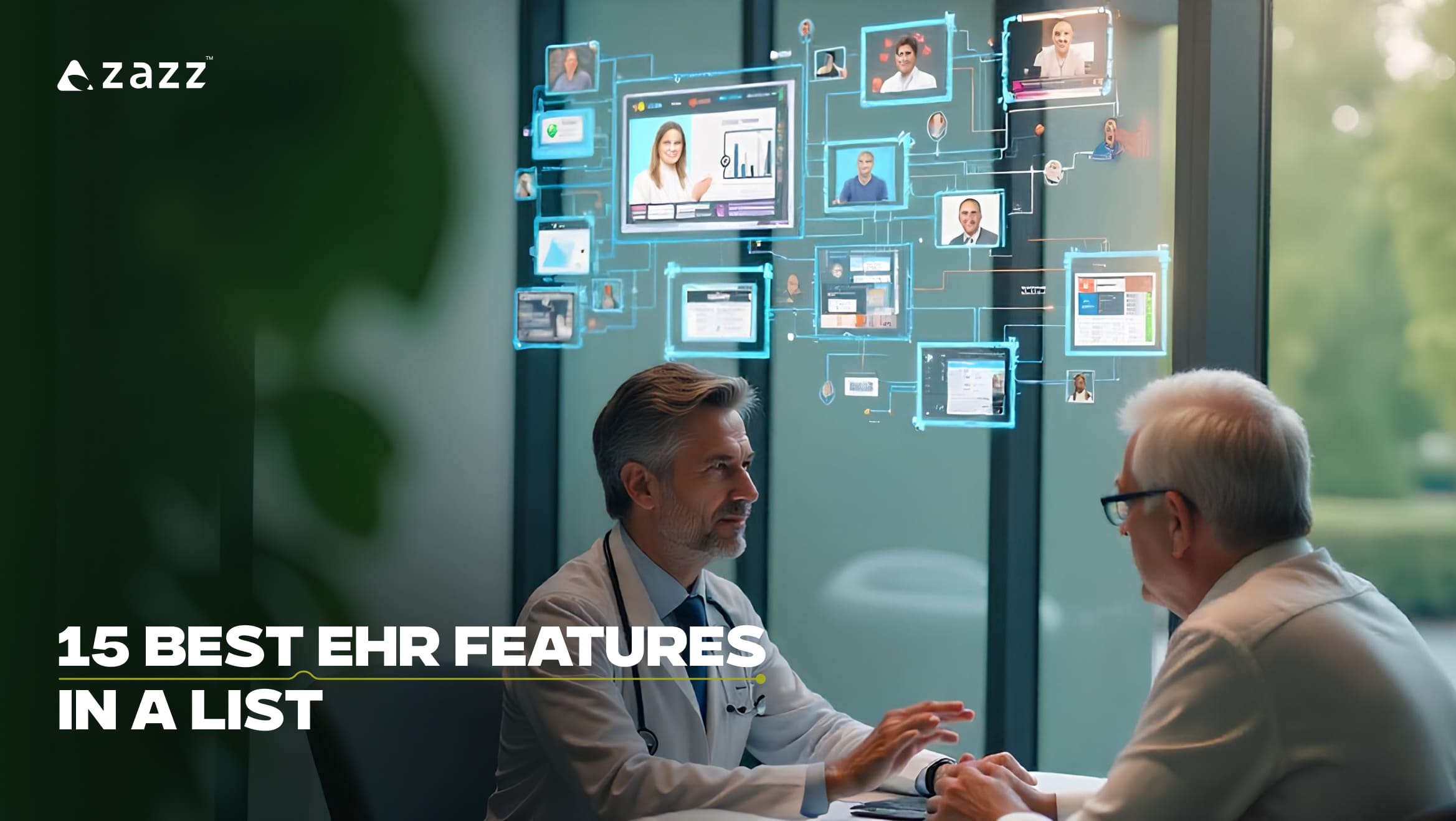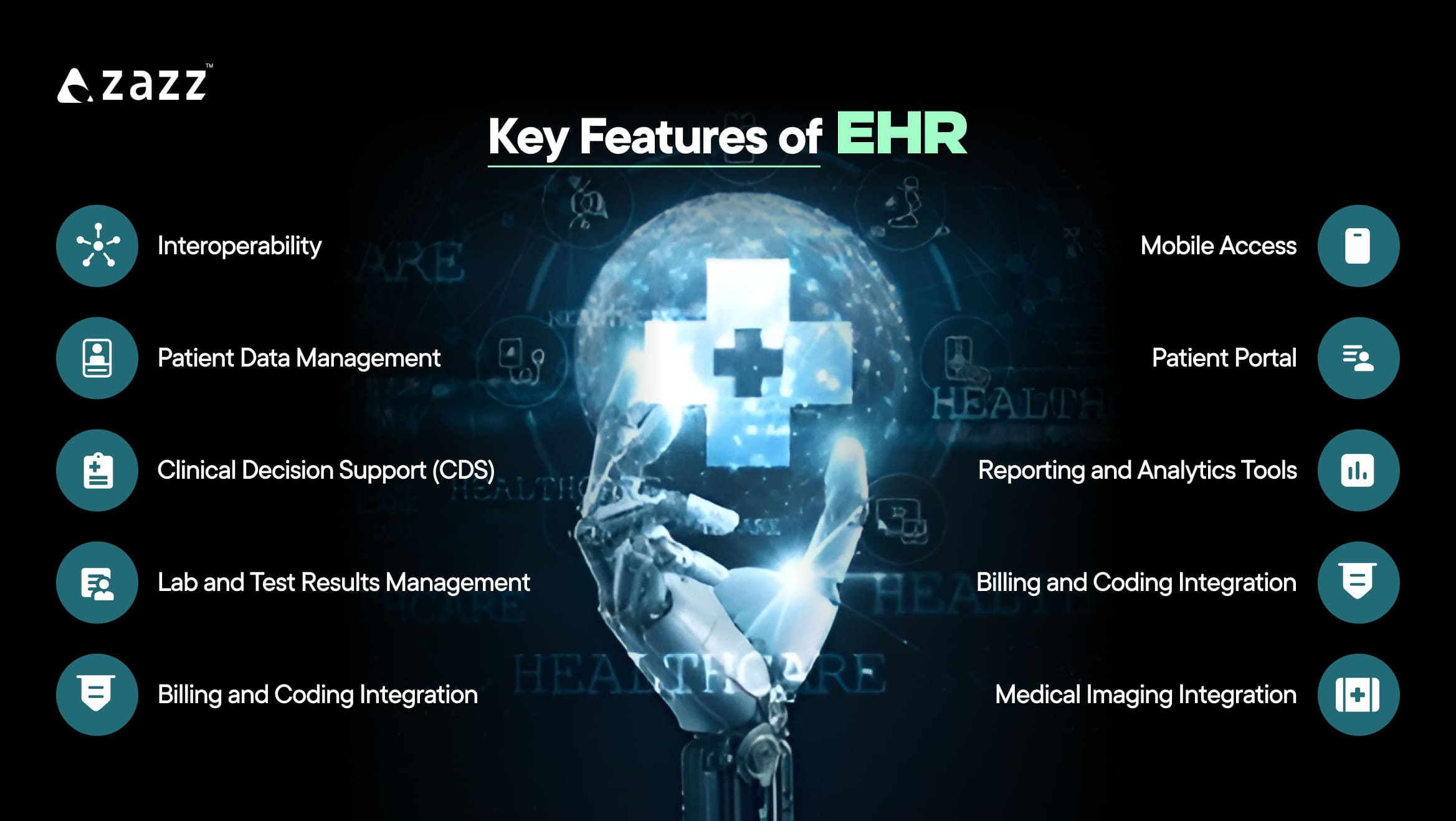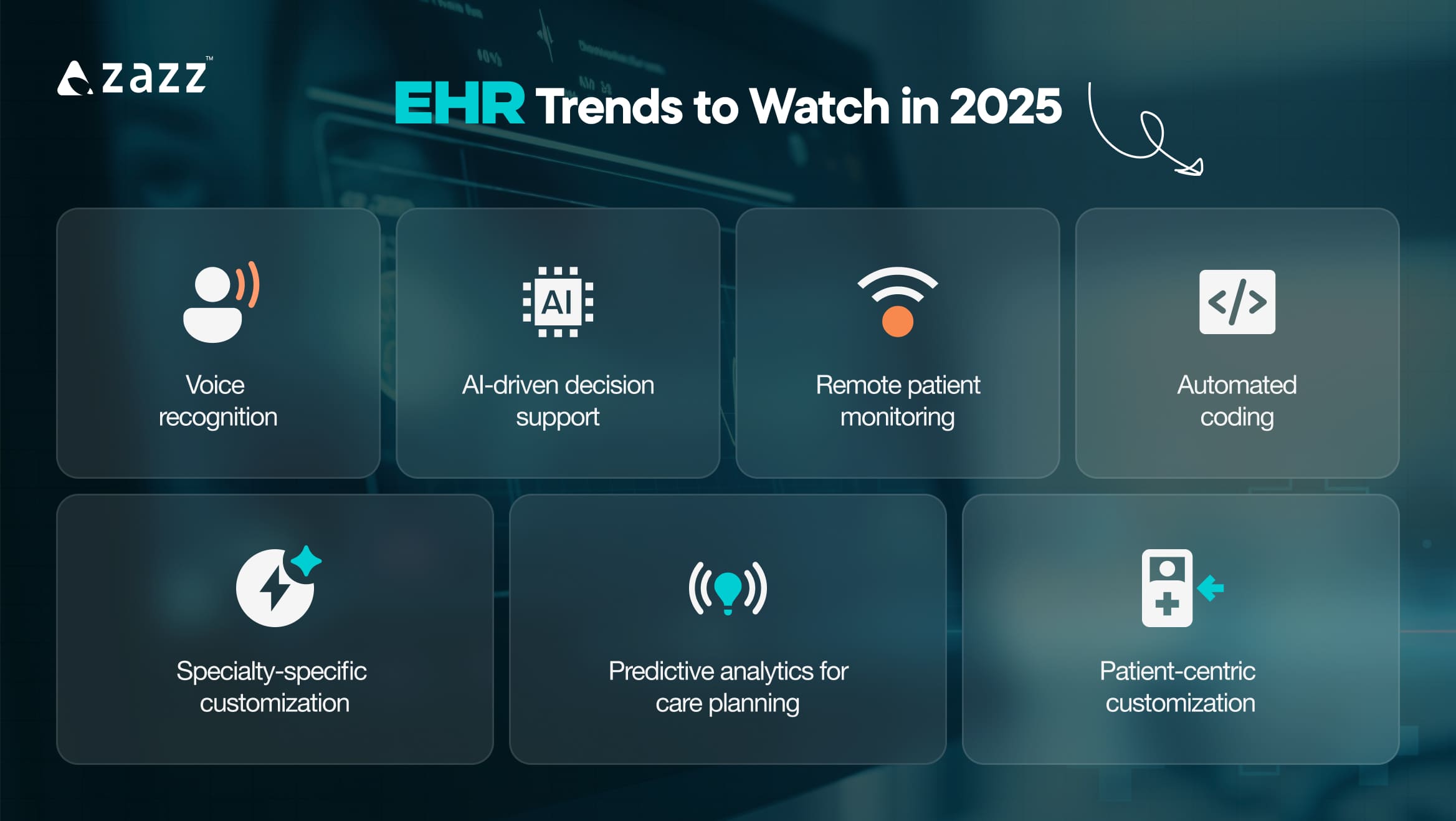
Healthcare space has become so advanced today that Electronic Health Records (EHR) have become an indispensable tool for improving patient care, streamlining operations, and ensuring better clinical outcomes. A robust EHR software offers a variety of functionalities that transform how healthcare providers manage patient data, communicate, and deliver care. Understanding the key EHR features is essential for healthcare professionals looking to choose the right system for their practice.
In this blog, we’ll explore an EHR features list that highlights the most important features of an EHR system, and how each can enhance the efficiency, security, and quality of healthcare delivery. Whether you’re new to EHRs or looking to upgrade your existing system, these features are essential for any modern healthcare practice aiming to stay ahead in the digital age.
Choosing the Right EHR Software Features For Your Practice!
When choosing EHR features, it’s essential to carefully evaluate the specific needs of your healthcare practice, considering both the common features of EHR and the unique requirements of your workflow.
- One of the first factors to consider is the usability of the system; it should be user-friendly and adaptable to the specific needs of your staff, ensuring that physicians, nurses, and administrative personnel can easily navigate the software.
- Another critical factor is Healthcare interoperability—the ability of the EHR to seamlessly exchange data with other healthcare systems, such as lab results, imaging systems, and pharmacy databases. This is crucial for ensuring efficient coordination of care.
- Additionally, the security and privacy of patient data must be a priority, so it’s essential that the system includes robust encryption and compliance with regulations like HIPAA.
- Furthermore, while features of an EHR system like patient scheduling, e-prescribing, and clinical decision support are common across most solutions, you should assess whether the system can be customized to fit the specific needs of your practice, such as specialty-specific templates or reporting tools.
- Finally, consider the level of customer support and training offered by the software provider to ensure smooth implementation and ongoing use. By thoroughly evaluating these factors, you can choose an EHR system that not only meets industry standards but also enhances your practice’s efficiency, patient care, and overall functionality.
Related reading: How to Build an EHR System: A Comprehensive Guide
For practical guidance on building an EHR software for your organization, get in touch with experts at Zazz, a trusted healthcare app development company in the US.
15 Key features of EHR that you must consider in 2025

When selecting or evaluating EHR (Electronic Health Record) software development, it’s essential to ensure that the system includes key EHR features that can support efficient, high-quality patient care, streamline healthcare workflows, and maintain data security. Below are some of the important features an EHR system must have:
1. Patient Data Management
Feature: A robust system for managing patient records, including medical history, allergies, medications, immunizations, lab results, and treatment plans.
Why It’s Important: Centralized and organized patient data ensures healthcare providers can easily access accurate and up-to-date patient information, minimizing errors and improving decision-making.
2. Clinical Decision Support (CDS)
Feature: Built-in decision support tools that provide alerts, reminders, and recommendations based on clinical guidelines, such as drug interactions, potential allergies, and recommended treatments.
Why It’s Important: This feature improves patient safety, reduces medication errors, and supports evidence-based care by providing healthcare providers with real-time insights to help guide clinical decisions.
3. Interoperability
Feature: The ability to share and exchange data seamlessly with other healthcare systems, including hospitals, labs, pharmacies, and other specialists’ offices.
Why It’s Important: Interoperability ensures that patient data is easily shared across different healthcare providers, which is crucial for improving care coordination, especially for patients with complex conditions who see multiple specialists.
4. Appointment Scheduling and Reminders
Feature: Integrated scheduling tools that allow healthcare providers to schedule, reschedule, and manage patient appointments. Many systems also include automated reminders for patients.
Why It’s Important: Streamlining appointment management helps reduce no-shows, optimize clinic operations, and improve the patient experience by ensuring timely care.
5. Patient Portal
Feature: A secure online platform where patients can access their health information, schedule appointments, view lab results, and communicate directly with their healthcare providers.
Why It’s Important: A patient portal enhances patient engagement, improves communication between patients and providers, and gives patients more control over their health, leading to better health outcomes and satisfaction.
6. Medical Imaging Integration
Feature: The ability to integrate medical images (X-rays, CT scans, MRIs) directly into the EHR system.
Why It’s Important: The integration of images with other clinical data helps healthcare providers make quicker, more informed decisions. It allows doctors to view images alongside other patient information, reducing the time needed to diagnose and treat conditions.
7. Billing and Coding Integration
Feature: Built-in tools for coding diagnoses and treatments according to standardized medical codes (ICD-10, CPT, etc.), as well as features for generating and submitting claims.
Why It’s Important: Integration with billing and coding ensures accurate claims submission, reducing errors and delays in reimbursements. It helps practices stay compliant with insurance requirements and enhances revenue cycle management.
Related reading: EMR/EHR Interface:15 Key Principles for User-Friendly Design
8. Lab and Test Results Management
Feature: The ability to integrate lab results directly into the patient’s digital record, automatically importing data from external labs or diagnostic tests.
Why It’s Important: Quick and easy access to test results within the EHR reduces the likelihood of errors and delays. It ensures that providers have all relevant information in real-time, allowing for faster diagnosis and treatment.
9. Data Security and Privacy Compliance
Feature: Advanced security features such as encryption, user authentication, audit trails, and role-based access controls, ensuring compliance with healthcare privacy laws like HIPAA (Health Insurance Portability and Accountability Act).
Why It’s Important: EHRs store sensitive patient data, and robust security features are essential to protect this information from breaches, unauthorized access, and cyber threats. Compliance with privacy regulations also builds trust with patients and ensures the practice meets legal requirements.
10. Customization and Workflow Optimization
Feature: EHR software should be customizable to fit the specific needs of a healthcare practice, whether it’s a small private practice or a large hospital. Customizable templates, user interface, and workflows make it easier for providers to adapt the system to their specific clinical or administrative needs.
Why It’s Important: Customization allows practices to tailor the system to their unique processes, improving efficiency and ensuring that the EHR integrates smoothly with daily workflows. It also improves user satisfaction as the system can be aligned with how the practice operates.
11. Electronic Prescribing (e-Prescribing)
Feature: The ability to electronically send prescriptions to pharmacies, reducing reliance on paper prescriptions.
Why It’s Important: E-prescribing reduces errors associated with handwritten prescriptions, improves medication safety, and speeds up the prescription process. It also helps healthcare providers track patient medications and avoid harmful drug interactions.
12. Real-Time Alerts and Notifications
Feature: Real-time notifications about critical lab results, patient allergies, potential medication conflicts, or other important clinical events.
Why It’s Important: Alerts ensure that healthcare providers are immediately informed of any critical changes in a patient’s health status, allowing them to act quickly to prevent adverse outcomes.
13. Reporting and Analytics Tools
Feature: Built-in reporting and analytics tools that allow healthcare providers to track patient outcomes, measure treatment effectiveness, and analyze practice performance.
Why It’s Important: These tools help practices monitor quality, identify areas for improvement, and support clinical decision-making. They also assist with compliance reporting and making data-driven decisions to improve patient care.
14. Mobile Access
Feature: Mobile compatibility that allows healthcare providers to access patient records, schedule appointments, and communicate with patients from smartphones or tablets.
Why It’s Important: Mobile access provides flexibility for healthcare providers to manage their practice, even when they’re on the go. This improves workflow, allows providers to make timely decisions, and supports telemedicine initiatives.
15. Multi-User Access and Role-Based Permissions
Feature: EHR systems must allow for multiple users with different roles (e.g., doctors, nurses, administrative staff) to access relevant patient data while ensuring sensitive information is only available to authorized personnel.
Why It’s Important: Role-based permissions ensure data security and help maintain confidentiality. Different users can access only the information they need, while the system remains secure and compliant with privacy regulations.
Related reading: What Is Interoperability in Healthcare? Complete Guide
Looking to optimize your existing EHR system with better features or planning to build a new one? Zazz provides cutting-edge EHR software solutions tailored to the unique needs of your practice. Get in touch
10 EHR trends to watch in 2025

The future of EHR systems will likely involve greater interoperability, enhanced functionality, and the integration of emerging technologies like artificial intelligence (AI), machine learning, and blockchain. Below are some key trends and expectations for the evolution of EHR system features:
Voice recognition: Advanced voice-to-text technology will allow healthcare providers to document patient encounters in real-time, reducing the time spent on manual data entry.
AI-driven decision support: EHRs will use AI to provide real-time recommendations, flag potential issues like drug interactions, suggest treatment plans based on best practices, and identify patterns in patient data to predict outcomes or complications.
Automated coding: AI will assist in automatically assigning the correct codes for diagnoses and procedures, improving billing accuracy and efficiency.
Predictive analytics for care planning: AI will help forecast potential patient outcomes based on clinical history and data, allowing for more proactive care planning.
Specialty-specific customization: EHR systems will offer more robust features tailored to specific medical fields such as pediatrics, cardiology, mental health, or oncology, improving efficiency and accuracy.
Patient-centric customization: The ability to customize EHR templates, patient intake forms, and communication preferences to better serve individual patients and patient groups will become a growing priority.
Adaptive systems: EHR systems will become more adaptive, changing their interface and workflows based on user preferences and evolving healthcare needs.
Proactive health management: EHR systems will use data from these devices to flag early signs of deterioration, prompting healthcare providers to intervene before a medical issue becomes critical.
Remote patient monitoring: Integration with wearables will allow for more effective telehealth and remote patient management, particularly in managing chronic diseases like diabetes, hypertension, and asthma.
Related reading: Top 5 Healthcare Mobile App Features
Conclusion:
Choosing the right EHR features for your practice is a crucial decision that requires careful consideration of several factors, from usability and interoperability to cost, security, and vendor support. By evaluating your practice’s specific needs, prioritizing critical features, and selecting a system that aligns with your long-term goals, you can enhance operational efficiency, improve patient care, and ensure your practice is equipped for future success. Remember, the right EHR features will not only streamline your workflow but also help you provide higher-quality, patient-centered care.
Transform Your Healthcare Practice with Custom Software Solutions!
At Zazz, we deliver tailored healthcare software designed to optimize your workflows, improve patient outcomes, and enhance overall efficiency. From EHR systems to telemedicine platforms, we create innovative solutions that meet the unique needs of your practice.
Ready to Elevate Your Healthcare Practice with Innovative EHR Software Solutions? Get in touch with us today!
Frequently Asked Questions
An Electronic Health Record (EHR) system is a digital version of a patient’s medical history, which is maintained and updated by healthcare providers across multiple settings.
EHRs improve patient care, reduce errors, streamline administrative tasks, ensure better coordination between providers, and enhance data security.
By providing real-time access to patient data, EHR systems enable faster, more accurate diagnosis, personalized treatment plans, and better follow-up care.
Yes, EHR systems use encryption, secure login, and regular audits to protect patient data and ensure compliance with privacy regulations like HIPAA.
Yes, EHRs can integrate with lab systems, imaging systems, pharmacies, and billing software to streamline processes and improve care coordination.
EHR systems save time, reduce paperwork, enhance communication, and improve clinical decision-making, leading to more efficient operations and better patient outcomes.
Recent Articles
Table of Content 1. Data Engineer vs. Data Scientist: Understanding...
Table of Content 1. What is the Carnival in Brazil?...
Table of Content 1. What is IT Staff Augmentation? 2....












